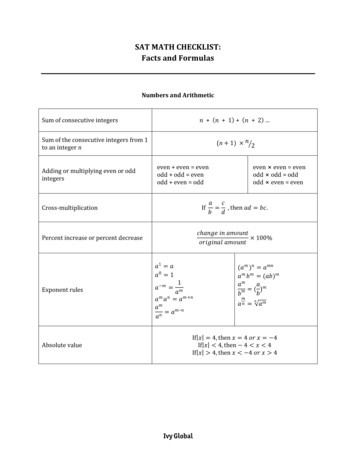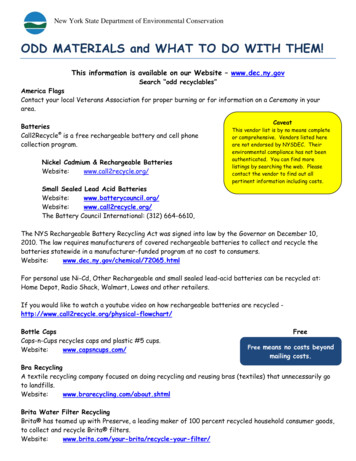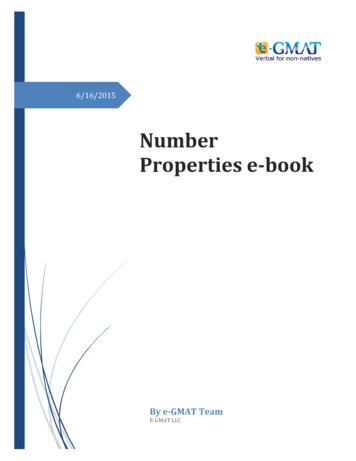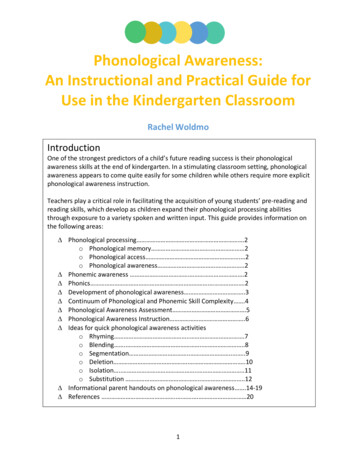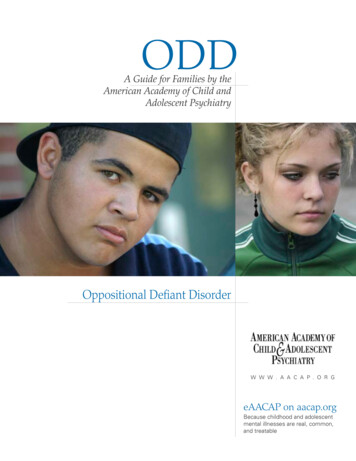
Transcription
ODDA Guide for Families by theAmerican Academy of Child andAdolescent PsychiatryOppositional Defiant Disorderw w w . a a c a p . o r geAACAP on aacap.orgBecause childhood and adolescentmental illnesses are real, common,and treatable
ODD: A Guide for FamiliesniiTable of ContentsWhat Is Oppositional Defiant Disorder (ODD)? 1How Common Is ODD? 2What Causes ODD? 3What Are the Symptoms of ODD?4How Is ODD Diagnosed? 5Can ODD Occur with Other Conditions? 6Can ODD Be Prevented?How Is ODD Treated?88How Long Does Treatment Typically Last?Does ODD Improve over Time?1212Which Therapies Have Been Shown Not to Work? 13What Does the Future Hold?References1314Oppositional Defiant Disorder: A Guide for Families is adapted from the American Academy of Child andAdolescent Psychiatry’s Practice Parameter for the Assessment and Treatment of Children and Adolescents withOppositional Defiant Disorder. The AACAP Practice Parameter was written to aid clinicians, child and adolescentpsychiatrists, physicians, and other healthcare professionals in the diagnosis and treatment of children withODD. This guide was adapted from the AACAP Practice Parameter in 2009.This publication is protected by copyright and can be reproduced with the permission of the AmericanAcademy of Child and Adolescent Psychiatry. 2009 The American Academy of Child and Adolescent Psychiatry, all rights reseved.eAACAP on aacap.orgBecause childhood and adolescentmental illnesses are real, common,and treatable
ODD: A Guide for Familiesn1What Is OppositionalDefiant Disorder?Oppositional defiant disorder (ODD) is one of agroup of behavioral disorders called disruptive behavior disorders (DBD). These disorders are calledthis because children who have these disorderstend to disrupt those around them. ODD is one ofthe more common mental health disorders foundin children and adolescents.Physicians define ODD as a pattern of disobedient, hostile, and defiant behavior directed towardauthority figures. Children and adolescents withODD often rebel, are stubborn, argue with adults,and refuse to obey. They have angry outbursts andhave a hard time controlling their temper.Even the best-behaved children can be uncooperative and hostile at times,particularly adolescents, but those with ODD show a constant pattern of angryand verbally aggressive behaviors, usually aimed at parents and other authorityfigures.The most common behaviors that children and adolescents with ODDshow are: DefianceSpitefulnessNegativityHostility and verbal aggressionA mental health professional is often called upon if these behaviors create amajor disturbance at home, at school, or with peers.Seeking treatment for children and adolescents suspected of having ODD iscritical. This disorder is often accompanied by other serious mental healthdisorders, and, if left untreated, can develop into conduct disorder (CD), a moreserious disruptive behavior disorder. Children with ODD who are not treatedalso are at an increased risk for substance abuse and delinquency.Oppositional Defiant Disorder: A Guide for Families is adapted from the American Academy of Child andAdolescent Psychiatry’s Practice Parameter for the Assessment and Treatment of Children and Adolescents withOppositional Defiant Disorder. The AACAP Practice Parameter was written to aid clinicians, child and adolescentpsychiatrists, physicians, and other healthcare professionals in the diagnosis and treatment of children withODD. This guide was adapted from the AACAP Practice Parameter in 2009.This publication is protected by copyright and can be reproduced with the permission of the AmericanAcademy of Child and Adolescent Psychiatry. 2009 The American Academy of Child and Adolescent Psychiatry, all rights reseved.eAACAP on aacap.orgBecause childhood and adolescentmental illnesses are real, common,and treatable
ODD: A Guide for Familiesn2Some parents have trouble seeing defiant behaviors as a symptom of a mentaldisorder. They may want to wait to start treatment until the child matures tosee if he or she will “grow out of it.”Also, it is sometimes difficult to distinguishbetween ODD and normal, independence-seeking behavior that shows upduring the “terrible twos” and early teen years.However, there is evidence to suggest that early intervention and treatment willhelp a child overcome ODD. Treatment also may prevent its progression into amore a serious mental health concern.Treatment usually consists of a combination of therapies, including behavioraltherapy, parent training, and family therapy. Some children may benefit frommedication as well.With treatment, children and adolescents can overcome the behavioral symptoms of ODD. They can learn techniques to manage their anger and developnew ways of coping with stressful situations. Treatment also can help parentslearn better ways to discipline and techniques to reward good behavior.With treatment, children and adolescents with ODD can overcome theirdifficult behaviors and lead happier, more fulfilling lives.How Common Is ODD?There is a range of estimates for how many children and adolescents haveODD. Evidence suggests that between 1 and 16 percent of children andadolescents have ODD.1 However, there is not very much information onthe prevalence of ODD in preschool children, and estimates cannot be made.2ODD usually appears in late preschool or early school-aged children. Inyounger children, ODD is more common in boys than girls. However, inschool-age children and adolescents the condition occurs about equally inboys and girls.3Although the disorder seems to occur more often in lower socioeconomicgroups, ODD affects families of all backgrounds.Oppositional Defiant Disorder: A Guide for Families is adapted from the American Academy of Child andAdolescent Psychiatry’s Practice Parameter for the Assessment and Treatment of Children and Adolescents withOppositional Defiant Disorder. The AACAP Practice Parameter was written to aid clinicians, child and adolescentpsychiatrists, physicians, and other healthcare professionals in the diagnosis and treatment of children withODD. This guide was adapted from the AACAP Practice Parameter in 2009.This publication is protected by copyright and can be reproduced with the permission of the AmericanAcademy of Child and Adolescent Psychiatry. 2009 The American Academy of Child and Adolescent Psychiatry, all rights reseved.eAACAP on aacap.orgBecause childhood and adolescentmental illnesses are real, common,and treatable
ODD: A Guide for Familiesn3What Causes ODD?There is no clear-cut cause of ODD. However,most experts believe that a combination of biological, psychological, and social risk factors play a rolein the development of the disorder.4Biological FactorsChildren and adolescents are more susceptible todeveloping ODD if they have: A parent with a history of attention-deficit/hyperactivity disorder (ADHD), ODD, or CD A parent with a mood disorder (such asdepression or bipolar disorder) A parent who has a problem with drinking orsubstance abuse Impairment in the part of the brain responsiblefor reasoning, judgment, and impulse control A brain-chemical imbalance A mother who smoked during pregnancy Exposure to toxins Poor nutritionPsychological Factors A poor relationship with one or more parent A neglectful or absent parent A difficulty or inability to form socialrelationships or process social cuesSocial Factors PovertyChaotic environmentAbuseNeglectLack of supervisionUninvolved parentsInconsistent disciplineFamily instability (such as divorce or frequent moves)Oppositional Defiant Disorder: A Guide for Families is adapted from the American Academy of Child andAdolescent Psychiatry’s Practice Parameter for the Assessment and Treatment of Children and Adolescents withOppositional Defiant Disorder. The AACAP Practice Parameter was written to aid clinicians, child and adolescentpsychiatrists, physicians, and other healthcare professionals in the diagnosis and treatment of children withODD. This guide was adapted from the AACAP Practice Parameter in 2009.This publication is protected by copyright and can be reproduced with the permission of the AmericanAcademy of Child and Adolescent Psychiatry. 2009 The American Academy of Child and Adolescent Psychiatry, all rights reseved.eAACAP on aacap.orgBecause childhood and adolescentmental illnesses are real, common,and treatable
ODD: A Guide for Familiesn4What Are the Symptoms of ODD?Most children argue with parents and defy authority from time to time,especially when they are tired, hungry, or upset. Some of the behaviorsassociated with ODD also can arise in children who are undergoing atransition, who are under stress, or who are in the midst of a crisis. Thismakes the behavioral symptoms of ODD sometimes difficult for parents todistinguish from expectable stress-related behaviors.5Children with ODD show an ongoing pattern of extreme negativity, hostility,and defiance that: Is constantLasts at least 6 monthsIs excessive compared with what is usual for the child’s ageIs disruptive to the family and the schoolIs usually directed toward an authority figure (parents, teachers,principal, coach)The following behavioral symptoms are associated with ODD: Frequent temper tantrumsExcessive arguments with adultsActively refusing to comply with requests and rulesOften questioning rulesDeliberately annoying and upsetting othersOften touchy or annoyed by othersBlaming others for their mistakesFrequent outbursts of anger and resentmentSpiteful attitude and revenge seekingTypically, children with ODD do not engage in delinquent behavior. Also,children whose behavioral symptoms are specifically related to a mood disorder,such as depression or bipolar disorder, are usually not diagnosed with ODD.Recently, it has been discovered that girls may show the symptoms of ODDdifferently than boys. Girls with ODD may show their aggressiveness throughwords rather than actions and in other indirect ways. For example, girls withODD are more apt to lie and to be uncooperative while boys are more likely tolose their temper and argue with adults.6Oppositional Defiant Disorder: A Guide for Families is adapted from the American Academy of Child andAdolescent Psychiatry’s Practice Parameter for the Assessment and Treatment of Children and Adolescents withOppositional Defiant Disorder. The AACAP Practice Parameter was written to aid clinicians, child and adolescentpsychiatrists, physicians, and other healthcare professionals in the diagnosis and treatment of children withODD. This guide was adapted from the AACAP Practice Parameter in 2009.This publication is protected by copyright and can be reproduced with the permission of the AmericanAcademy of Child and Adolescent Psychiatry. 2009 The American Academy of Child and Adolescent Psychiatry, all rights reseved.eAACAP on aacap.orgBecause childhood and adolescentmental illnesses are real, common,and treatable
ODD: A Guide for Familiesn5How Is ODDDiagnosed?While there is no single test that can diagnoseODD, a mental health professional can determinewhether a child or adolescent has the disorderby assessing the child’s symptoms and behaviorsand by using clinical experience to make adiagnosis.Many parents first call upon the child’s primarycare physician for an evaluation. This evaluationtypically begins by compiling a medical historyand performing a physical examination.Gathering InformationDuring the evaluation, the child’s primary care clinician will look for physicalor other mental health issues that may cause problems with behavior. If thedoctor cannot find a physical cause for the symptoms, he or she may refer thechild to a child and adolescent psychiatrist or a mental health professional whois trained to diagnose and treat mental illnesses in children and adolescents.A child and adolescent psychiatrist or a qualified mental health professionalusually diagnoses ODD.A mental health professional will gather information from parents, teachers,and daycare providers as well as from the child.Gathering information from as many people as possible will help the doctordetermine how often the behaviors occur and where. It also will help thedoctor determine how the behaviors affect the different areas of the child’s life.The mental health professional will determine whether: The behavior is severe The conflicts are with peers or authority figures The behavior is a result of stressful situations within the home The child reacts negatively to all authority figures, or only his or her parentsor guardiansOppositional Defiant Disorder: A Guide for Families is adapted from the American Academy of Child andAdolescent Psychiatry’s Practice Parameter for the Assessment and Treatment of Children and Adolescents withOppositional Defiant Disorder. The AACAP Practice Parameter was written to aid clinicians, child and adolescentpsychiatrists, physicians, and other healthcare professionals in the diagnosis and treatment of children withODD. This guide was adapted from the AACAP Practice Parameter in 2009.This publication is protected by copyright and can be reproduced with the permission of the AmericanAcademy of Child and Adolescent Psychiatry. 2009 The American Academy of Child and Adolescent Psychiatry, all rights reseved.eAACAP on aacap.orgBecause childhood and adolescentmental illnesses are real, common,and treatable
ODD: A Guide for Familiesn6Answering these questions will help a mental health professional determinewhether the child or adolescent has developed ODD or is responding to ashort-lived, stressful situation.Assessment tools, such as rating scales and questionnaires, may help thechild’s doctor measure the severity of the behaviors. These tools also may assistin establishing a diagnosis and tracking progress once treatment begins.7In addition to establishing a primary diagnosis, the doctor will look for signsof other conditions that often occur along with ODD, such as ADHD, anxiety,and mood disorders. The doctor also should look for signs that the child hasbeen involved in bullying—as either the victim or perpetrator. Involvement inbullying often is a sign that the child is at risk for aggression and violence.8Establishing a RelationshipLike many mental health disorders, ODD is not always easy to accuratelydiagnose. Open communication among the mental health professionaland the parents and child can help overcome the difficulties diagnosing thisdisorder. For example, some children see their behaviors as justified andare unmotivated to change. Also, some parents can become defensive whenquestioned about their parenting style. Having the parent and the child viewthe mental health professional as an ally can help.9Establishing a good relationship with a mental health professionalis important to determining whether the child’s behavior is a response toa short-lived situation or transition, ODD, or another serious behavioralcondition, such as CD or a mood disorder.Can ODD Occur withOther Conditions?Many children who are diagnosed with ODD also have other treatablemental health and learning conditions. Having more than one conditionis called having coexisting conditions. Some conditions that coexist withODD are: ADHDAnxiety disordersMood disorders (such as depression and bipolar disorder)Learning disordersLanguage disordersOppositional Defiant Disorder: A Guide for Families is adapted from the American Academy of Child andAdolescent Psychiatry’s Practice Parameter for the Assessment and Treatment of Children and Adolescents withOppositional Defiant Disorder. The AACAP Practice Parameter was written to aid clinicians, child and adolescentpsychiatrists, physicians, and other healthcare professionals in the diagnosis and treatment of children withODD. This guide was adapted from the AACAP Practice Parameter in 2009.This publication is protected by copyright and can be reproduced with the permission of the AmericanAcademy of Child and Adolescent Psychiatry. 2009 The American Academy of Child and Adolescent Psychiatry, all rights reseved.eAACAP on aacap.orgBecause childhood and adolescentmental illnesses are real, common,and treatable
ODD: A Guide for Familiesn7Research indicates that some children developthe behavioral symptoms of ODD as a way tomanage anxiety or uncertainty.10 Anxiety disorders and mood disorders are similar to ODDin that they are often a response to uncertaintyand an unstable home and school environment.These similarities make it more likely that ODDand anxiety disorder and a mood disorder (suchas depression) will occur together.11Among all conditions that coexist with ODD,ADHD is the most common. Both disordersshare common symptoms of disruptive behaviors. However, children and adolescents whohave both ODD and ADHD tend to be moreaggressive, have more of the negative behavioral symptoms of ODD, andperform less well in school than those who have ODD alone. These childrenalso tend to have more disruption in their families and with their relationshipswith authority figures than children who do not have ODD.12Doctors have found that ODD can be a precursor to CD. CD is a more seriousbehavioral disorder that can result in destructive antisocial behavior.While ODD behaviors may start in early preschool years, CD usually appearswhen children are older. A child or adolescent who has ADHD as a coexisting condition also seems to be at increased risk of developing CD. In addition,studies show that having CD puts children and adolescents at risk of developing a mood disorder or antisocial personality disorder later in life.13While having ODD and a coexisting condition puts a child at risk for developing other more serious mental health issues, treatments exist that can improvethe symptoms of ADHD, anxiety disorders, mood disorders, and learning andlanguage disorders. Also, treating other mental health and learning conditionsthat occur along with ODD has been shown to decrease the behavioral symptoms of ODD.Oppositional Defiant Disorder: A Guide for Families is adapted from the American Academy of Child andAdolescent Psychiatry’s Practice Parameter for the Assessment and Treatment of Children and Adolescents withOppositional Defiant Disorder. The AACAP Practice Parameter was written to aid clinicians, child and adolescentpsychiatrists, physicians, and other healthcare professionals in the diagnosis and treatment of children withODD. This guide was adapted from the AACAP Practice Parameter in 2009.This publication is protected by copyright and can be reproduced with the permission of the AmericanAcademy of Child and Adolescent Psychiatry. 2009 The American Academy of Child and Adolescent Psychiatry, all rights reseved.eAACAP on aacap.orgBecause childhood and adolescentmental illnesses are real, common,and treatable
ODD: A Guide for Familiesn8Can ODD BePrevented?There is research that shows that early-interventionand school-based programs along with individualtherapy can help prevent ODD.14Among preschoolers, the Head Start program hasbeen shown to help children do well in school andprevent delinquency later in life. Head Start is a program of the United States Department of Health andHuman Services (US-HHS) that provides education,health, and other services to low-income children andtheir families. Young children in this program learnsocial skills and how to resolve conflict and manageanger.15 A home visit to high-risk children alsohas been shown to help prevent ODD among preschoolers.16Among adolescents, psychotherapy (talk therapy), social-skills training,vocational training, and help with academics can help reduce disruptivebehavior. In addition, school-based programs can be effective in stoppingbullying, reducing antisocial behavior, and improving peer relationships.17Parent-management training programs have proven effective in preventingODD among all age groups. These programs teach parents how to develop anurturing and secure relationship with their child and how to set boundaries forunacceptable behavior.18 More information about parent-management trainingcan be found on page nine of this guide.How Is ODD Treated?There is no one-size-fits-all treatment for children and adolescents with ODD.The most effective treatment plans are tailored to the needs and behavioralsymptoms of each child. Treatment decisions are typically based on a numberof different things, including the child’s age, the severity of the behaviors, andwhether the child has a coexisting mental health condition.19Oppositional Defiant Disorder: A Guide for Families is adapted from the American Academy of Child andAdolescent Psychiatry’s Practice Parameter for the Assessment and Treatment of Children and Adolescents withOppositional Defiant Disorder. The AACAP Practice Parameter was written to aid clinicians, child and adolescentpsychiatrists, physicians, and other healthcare professionals in the diagnosis and treatment of children withODD. This guide was adapted from the AACAP Practice Parameter in 2009.This publication is protected by copyright and can be reproduced with the permission of the AmericanAcademy of Child and Adolescent Psychiatry. 2009 The American Academy of Child and Adolescent Psychiatry, all rights reseved.eAACAP on aacap.orgBecause childhood and adolescentmental illnesses are real, common,and treatable
ODD: A Guide for Familiesn9The goals and circumstances of the parentsalso are important when forming a treatmentplan. In many cases, treatment may last severalmonths or more and requires commitment andfollow-through by parents as well as by othersinvolved in the child’s care.Types of TreatmentTreatment usually consists of a combination of: Parent-Management Training Programs andFamily Therapy to teachparents and other family members how tomanage the child’s behavior.Parents, family members, and other caregivers are taught techniques inpositive reinforcement and ways to disciplinemore effectively. Cognitive Problem-Solving Skills Training to reduce inappropriate behaviors by teaching the child positive ways of responding to stressful situations.Children with ODD often only know of negative ways of interpretingand responding to real-life situations. Cognitive problem solving skillstraining teaches them how to see situations and respond appropriately. Social-Skills Programs and School-Based Programs to teach children andadolescents how to relate more positively to peers and ways to improve theirschool work. These therapies are most successful when they are conductedin a natural environment, such as at the school or in a social group. Medication may be necessary to help control some of the more distressingsymptoms of ODD as well as the symptoms of coexisting conditions, suchas ADHD, anxiety, and mood disorders. However, medication alone is nota treatment for ODD.Treatments for Each Age GroupFor preschool-age children, treatment often concentrates on parent-management training and education. School-age children perform best with a combination of school-based intervention, parent-management training, and individual therapy. For adolescents, individual therapy along with parent-managementtraining has been shown to be the most effective form of treatment.Oppositional Defiant Disorder: A Guide for Families is adapted from the American Academy of Child andAdolescent Psychiatry’s Practice Parameter for the Assessment and Treatment of Children and Adolescents withOppositional Defiant Disorder. The AACAP Practice Parameter was written to aid clinicians, child and adolescentpsychiatrists, physicians, and other healthcare professionals in the diagnosis and treatment of children withODD. This guide was adapted from the AACAP Practice Parameter in 2009.This publication is protected by copyright and can be reproduced with the permission of the AmericanAcademy of Child and Adolescent Psychiatry. 2009 The American Academy of Child and Adolescent Psychiatry, all rights reseved.eAACAP on aacap.orgBecause childhood and adolescentmental illnesses are real, common,and treatable
ODD: A Guide for Familiesn10In all age groups, individual therapy focusing on problem-solving skills also hasbeen shown to greatly improve the behavior of children and adolescents withODD. Problem-solving skills training should be specific to the child’s behavioral problems, geared to the child’s age, and focused on helping the child acquirenew problem-solving skills.More About Parent-Management TrainingStudies have shown that intervening with parents is one of the most effectiveways to reduce the behavioral symptoms of ODD in all age groups.20 Parentmanagement training teaches parents positive ways to manage their child’sbehavior, discipline techniques, and age-appropriate supervision. It is thetreatment of choice to prevent disruptive childhood behavior for manymental health professionals.This approach embraces the following principles: Increased positive parenting practices, such as providing supportive andconsistent supervision and discipline Decreased negative parenting practices, such as the use of harsh punishmentand focus on inappropriate behaviors Consistent punishment for disruptive behavior Predictable, immediate parental responseMany of the following programs and publications have been noted as positivemodels by the Substance Abuse and Mental Health Services Administration(SAMHSA) of the United States Health and Human Services (US-HHS):ProgramsProgram NameAge RangeContact InformationIncredible YearsUp to 8 yearswww.IncredibleYears.comTriple P-Positive Parenting ProgramUp to 13 yearshttp://www5.triplep.netParent-Child Interaction Therapy (PCIT)Up to 8 yearswww.pcit.orgCenter for Collaborative Problem SolvingUp to 18 yearswww.explosivechild.comThe Adolescent TransitionsProgram (ATP)11 to 13 yearshttp://cfc.uoregon.edu/atp.htmOppositional Defiant Disorder: A Guide for Families is adapted from the American Academy of Child andAdolescent Psychiatry’s Practice Parameter for the Assessment and Treatment of Children and Adolescents withOppositional Defiant Disorder. The AACAP Practice Parameter was written to aid clinicians, child and adolescentpsychiatrists, physicians, and other healthcare professionals in the diagnosis and treatment of children withODD. This guide was adapted from the AACAP Practice Parameter in 2009.This publication is protected by copyright and can be reproduced with the permission of the AmericanAcademy of Child and Adolescent Psychiatry. 2009 The American Academy of Child and Adolescent Psychiatry, all rights reseved.eAACAP on aacap.orgBecause childhood and adolescentmental illnesses are real, common,and treatable
ODD: A Guide for Familiesn11PublicationsBook NameAge RangePublication InformationThe Defiant Child by Douglas Riley, Ph.D.Up to 13 yearsThe Guilford PressThe Explosive Child by R.W. GreeneUp to 13 yearsHarper PaperbacksThe Kazdin Method for Parenting theDefiant Child by Allan E. Kazdin, Ph.D.Up to 18 yearsHoughton MifflinParent Management Training by Allan Kazdin Up to 18 yearsOxford University PressMultisystematic Treatment of AntisocialBehavior in Children and Adolescentsby Scott Henggeler, Sonja Schoenwald,Charles Borduin, and Melisa RowlandUp to 18 yearsThe Guilford PressHelping the Noncompliant Child byRobert McMahon and Rex ForehandUp to 18 yearsThe Guilford PressMedicationMedication alone has not been proven effective in treating ODD. However,medication may be a useful part of a comprehensive treatment plan to helpcontrol specific behaviors and to treat coexisting conditions, such as ADHD,anxiety, and mood disorders.Successful treatment of coexisting conditions often makes ODD treatmentmore effective. For example, medication used to treat children with ADHDhas been shown to lessen behavioral symptoms when ODD and ADHDcoexist. When children and adolescents with ODD also have a mood disorderor anxiety, treatment with antidepressants and anti-anxiety medications hasbeen show to help lessen the behavioral symptoms of ODD.21Early Identification and TreatmentBehaviors that go along with ODD are difficult to change. Therefore, earlyidentification and treatment of ODD give children and adolescents the bestchance for success.Oppositional Defiant Disorder: A Guide for Families is adapted from the American Academy of Child andAdolescent Psychiatry’s Practice Parameter for the Assessment and Treatment of Children and Adolescents withOppositional Defiant Disorder. The AACAP Practice Parameter was written to aid clinicians, child and adolescentpsychiatrists, physicians, and other healthcare professionals in the diagnosis and treatment of children withODD. This guide was adapted from the AACAP Practice Parameter in 2009.This publication is protected by copyright and can be reproduced with the permission of the AmericanAcademy of Child and Adolescent Psychiatry. 2009 The American Academy of Child and Adolescent Psychiatry, all rights reseved.eAACAP on aacap.orgBecause childhood and adolescentmental illnesses are real, common,and treatable
ODD: A Guide for Familiesn12How Long Does TreatmentTypically Last?Most treatment plans for children and adolescents with ODD last severalmonths or longer. For those with a more severe ODD, or ODD that does notrespond to therapy, treatment can last many years and may include placementin a treatment center.A residential treatment center only should be considered for families whoare not able to provide therapy at home or at school. In-home services arepreferable to residential placement and are often sponsored by state andlocal child welfare agencies.22Does ODD Improve over Time?For many children, ODD does improve over time. Follow-up studies havefound that approximately 67 percent of children diagnosed with ODD whoreceived treatment will be symptom-free after three years. However, studiesalso show that approximately 30 percent of children who were diagnosed withODD will go on to develop CD.23Other studies show that when the
oDD: a guide for Families n 1 Oppositional Defiant Disorder: A Guide for Families is adapted from the American Academy of Child and Adolescent Psychiatry's Practice Parameter for the Assessment and Treatment of Children and Adolescents with Oppositional Defiant Disorder. The AACAP Practice Parameter was written to aid clinicians, child and adolescent
